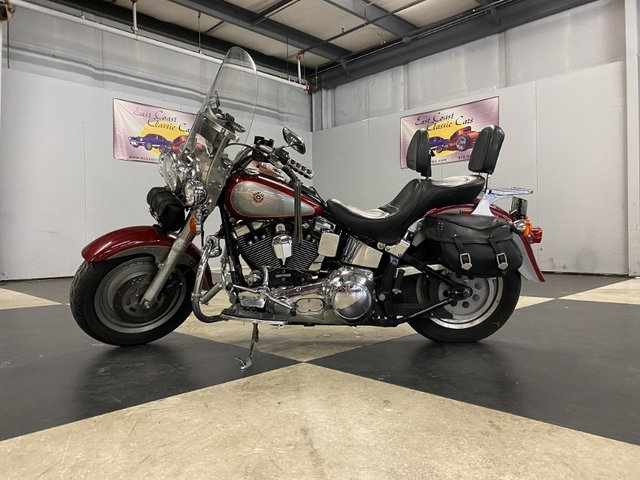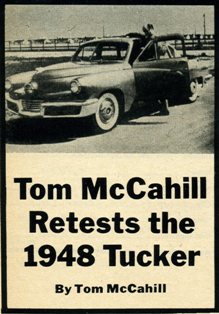|
The following article, "Tom McCahill Retest the 1948 Tucker" originally appeared in the February 1971 issue of Mechanix Illustrated.
On the way to the Ontario race track in California last fall I had in my pocket W.B. Hamlin's address, which just happened also to be in Ontario. Mr. Hamlin undoubtedly rates as the No. 1 Tucker fan in the country and I understood he had several at his home in running condition. If this was true I was anxious to get behind the wheel of one again because the last time I drove a Tucker was nearly a quarter of a century ago and it started a rhubarb of gigantic proportions that never quite ended.
Shortly after World War II, Preston Tucker announced he was about to build the world's most unusual car that would make every other car on the road seem old hat. He was right and he was wrong. His car was right but other manufacturers could hardly be called fans of his and Tucker never correctly estimated the millions of tons of stumbling blocks that would be tossed in his path.
In fact, there was some pretty good evidence that high-price sabotage had been employed to keep him from succeeding. But let's go back to the beginning, the day before I tested the Tucker.
Back in '48, Tucker was in financial trouble and also was being hurt by rumors running around the Detroit scene that his car was a failure engineering wise.
I was having lunch at the Dearborn Inn with a group of Ford men, which included the chief engineer and just about the entire public relations staff, when the subject of the Tucker came up. My companions asked whether I had tested it, I hadn't. There were loud guffaws and even some table thumping at the mention of the Tucker operation in Chicago. One of the PR men suggested we phone Tucker from the inn office and ask him when I could test his car. No writer had ever driven the Tucker, much less tested one.
Lunch over, we all headed for the phone and placed a call to Tucker at the factory. In a couple of minutes Tucker himself was on the phone and I guess I may have stuttered a bit as I told him, "Mr. Tucker, I'd like to test one of your new cars for MI as soon as possible."
His answer was pleasant and simple: "Any time you want." This threw me into a momentary tailspin and the Ford men in the room were aghast.
"How about tomorrow ?" I suggested. He said, "What time ?"
"Right after lunch," I said. And that's how I became the first writer to test a Tucker. Unknown to him, Mr. Ford picked up the phone bill.
To say everyone in the room was shocked would be the understatement of the century because all the talk at lunch had been about how he'd never get one running and that this was the stock promotion of all time.
According to the rumors running around Detroit there was no assembly line, paint shop or even assemblers working in the huge former B-29 factory that Tucker had rented for his operation. and I'd be lucky if I could find a watch man. I have no idea who paid the saboteurs or who was feeding the rumor mills back in Detroit.
When I arrived in Chicago the activities I ran into showed in an eyeblink that whoever was paying to sink Tucker wasn't succeeding. Looking back, it's too bad the saboteurs found out how in efficient they were because, possibly based on my reports, big money started to pour in to sink the Tucker and I became one of the victims as well.
Until my report came out, in addition to what I made at MI, I was getting a retainer from the biggest digest magazine of all time - none other than the Reader's Digest. After my favorable report on the car I was told that I had been taken in by Tucker and, therefore, my services would no longer be needed. Less than a week after this the No. 2 weekly magazine at the time (Collier's) had a scathing piece on the Tucker that said there weren't any cars that would run - oh, they might run but they didn't have a reverse - and many other things, all bad.
The next month this report ran in the digest magazine (which had first placed it in the weekly magazine) and, though it didn't help my bank account, both were later sued... and lost. However, by then the dirty work had been done. Those two major American publications had, in my opinion, a major part in sinking Tucker forever in spite of the fact that the Tucker was, as I tested it, the finest American car ever built until that date.
Twenty-three years ago when I arrived at the Tucker factory I not only found the production line and paint shop working but was given the choice of six cars to test. They were all powered by Franklin engines, which was a common engine of light aircraft in those days. In planes these engines were air-cooled but, for Tucker use, they were converted to liquid cooling. They were rated at 150 hp, though the dynamometer tests showed they averaged out at 177.
After selecting a car, I made many acceleration runs at the plant grounds and after getting a speedometer correction, found that I was averaging 0 to 60 in 10 sec., which was phenomenal 20-plus years ago. Incidentally, one of the first things I tested was the reverse gear and I used all six Tuckers for this. All six backed up without any fuss whatsoever, thus blowing another Detroit rumor in the head.
I then left the plant grounds and went out on Cicero Boulevard on the South Side of Chicago. The results? Well, I'll quote from our test in the August 1948 issue of this magazine (it's still my most often-quoted report): "Once outside the plant and on the road I knew I was in one of the greatest performing passenger automobiles ever built on this side of the Atlantic. I saw an open stretch ahead and I opened the throttle wide. In no time at all, it seemed, we were doing 90 on the clock, 95, 100 and then 105 mph. And we were still climbing when a truck loomed up ahead and I had to kill speed."
To find out how the Tucker performs today, 20 years later, I headed for Mr. Hamlin's place to take a look at his collection. As it turned out, it was less than 2 mi. from my motel, and cruising the block with Brooks, I saw three Tuckers in front of the garage where Mr. Hamlin was working.
Unfortunately, the better of the three mechanically, according to Mr. Hamlin, was his Serial No. 2 car but the paint and finish were in poor shape and it wouldn't be ready for another week or so, looks-wise. I settled for car No. 14 because it looked like it was fresh from the showroom floor and was finished in a blue metallic paint, identical to the car I had tested many years before.
Mr. Hamlin knows the history of just about every Tucker ever made and knows where most of them are today. Actually, there were 49 completed cars sold and the 50th car was assembled from parts after the plant was sold at auction. Many of these cars now are in museums ranging all the way from Florida to California but a few still are in private hands. Two were known to have been wrecked and there are rumors that there is one car in a museum in Brazil, another in Mexico City and the possibility of a third wrecked somewhere in Maryland.
Well, we found Mr. Hamlin's little beauty (and this car has better than 150,000 mi. on it) will still do 0 to 60 in 10 sec. flat and will zip by 100 as quickly as the car I drove years before. As far as Mr. Hamlin was concerned it was okay if we made a flat-out run on the Ontario Speedway but your Uncle Tom took the freeway instead and called a halt at around 105. With a car this old, not to mention with this many miles on it, a flat-out run, even for a few seconds, might be all that would be needed to cause something to blow. I'm not the kind that enjoys tearing up greatness.
Though Preston Tucker and many of the original crew have long since passed on, they once built the most advanced automobile in the world and somewhere in Detroit a group in villain suits with loaded pockets ran these cars into the ground - for shame!•
1948 Tucker Gallery
|

















